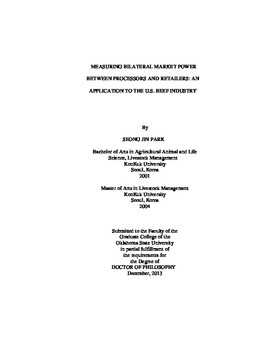| dc.contributor.advisor | Chung, Chanjin | |
| dc.contributor.author | Park, Seong Jin | |
| dc.date.accessioned | 2015-06-17T20:07:24Z | |
| dc.date.available | 2015-06-17T20:07:24Z | |
| dc.date.issued | 2013-12 | |
| dc.identifier.uri | https://hdl.handle.net/11244/19490 | |
| dc.description.abstract | The U.S. agricultural food processing and retailing industries have become increasingly concentrated. Therefore, numerous studies have investigated the impact of changes in market structures. This paper examines the importance of the bilateral relationship between retailers and processors in estimating market power parameters in imperfectly competitive markets. The model developed in this study allows one to estimate conjectural elasticities of input and output markets for processors and retailers separately without imposing the fixed proportions technology assumption. This study uses the primal approach to estimate the degree of market power without imposing the symmetry assumption on conjectural elasticities of input and output markets. To demonstrate the importance of considering the bilateral relationship between retailers and processors, we first generate industry data for market structures such as perfect competition, monopoly, monopsony, two-way bilateral competition, and four-way bilateral competition. The importance of using more general and flexible frameworks is demonstrated using likelihood dominance criterion (LDC), and biases in estimates of market power parameters and industry indices. We find that the model correctly estimates market power and flexible enough to consider the full range of the bilateral market power exertion. The four-way bilateral competition model is applied to the U.S. beef industry estimating conjectural elasticities from input and output markets, and corresponding market power indices. Sensitivity analysis is conducted using alternative functional forms of production function. Empirical results show that processors and retailers exercise market power in both input and output markets in the U.S. beef industry. Furthermore, estimated market power parameters and market power indices are sensitive to the choice of market structures and functional forms. | |
| dc.format | application/pdf | |
| dc.language | en_US | |
| dc.rights | Copyright is held by the author who has granted the Oklahoma State University Library the non-exclusive right to share this material in its institutional repository. Contact Digital Library Services at lib-dls@okstate.edu or 405-744-9161 for the permission policy on the use, reproduction or distribution of this material. | |
| dc.title | Measuring bilateral market power between processors and retailers: An application to the U.S. beef industry | |
| dc.contributor.committeeMember | Adam, Brian | |
| dc.contributor.committeeMember | Raper, Kellie | |
| dc.contributor.committeeMember | Currier, Kevin | |
| osu.filename | Park_okstate_0664D_12986.pdf | |
| osu.accesstype | Open Access | |
| dc.type.genre | Dissertation | |
| dc.type.material | Text | |
| dc.subject.keywords | bilateral | |
| dc.subject.keywords | market power | |
| thesis.degree.discipline | Agricultural Economics | |
| thesis.degree.grantor | Oklahoma State University | |
